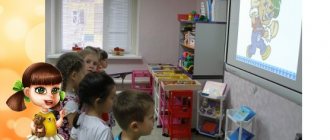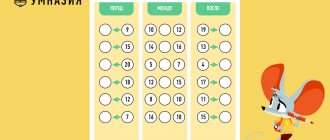10778_Master-class.docx
Master class "Use of game-based entertaining material in classes on the formation of elementary mathematical concepts in preschoolers." Conducted by: Olga Vladimirovna Shvedova Educator of the Children's Preschool Educational Institution "Beryozka" p. Mathematics is a science. It is good and everyone needs it. It is difficult for us to live without it. Without it, life is difficult for us. It is not for nothing that mathematics is called the “queen of sciences”. Its study sharpens the mind, increases the volume of attention and memory, develops logical thinking, and forms mental operations. By doing mathematics, children learn to analyze, compare, generalize, give reasons for their statements, and build simple conclusions. No one doubts or disputes the role of mathematics in the development of mankind. However, mathematics at school continues to be one of the most time-consuming subjects. How to be? How can we make learning mathematics more attractive and accessible, and how can we ease the transition from preschool to school education? Starting work on this topic, I became familiar with the currently existing methods for FEMF. These are works by such authors as: Leushin, Erofeev, Kolesnikov, Novikov, Solovyov, Peterson. Naturally, they all differ both in content and in the form of presentation of the material, but the common thing that determines all these methods is that all of the above authors focus on the game as a means, method and form of organizing the educational activities of preschoolers. That is, we, educators, should not forget that the leading activity in preschool age is play, which means the teacher’s goal is to teach the child to play, and in the process of play, slowly, imperceptibly introduce him to certain concepts and give him the necessary information. Let the children not see that they are being taught something, let them think that they are just playing, but immediately in the process of playing, preschoolers learn to count, add and subtract - moreover, they solve various kinds of logical riddles, learn to think creatively. And the role of an adult in this process is to support and direct the interest of children. When starting to work with a new group of children, it would be a good idea to study the child’s emotional well-being and his attitude towards mathematics. A projective conversation can help with this, which is conducted individually with each child in an atmosphere of goodwill and in the complete absence of an evaluative attitude on the part of an adult. One of the tests involves determining the child’s preference in choosing an activity. The teacher shows the child a table with images of five houses, each of them schematically depicts something that emphasizes belonging to a certain area: 1. “Math house” - decorated with numbers 2. House for reading and writing - with letters 3. Pencils on the house show what it is intended for for visual arts. 4. Book – here you can listen to fairy tales. 5. Toy – here you can play. The teacher asks the child: “There are houses in front of you - in one you can draw, in the other you can listen to fairy tales, in the third you can do mathematics, in the fourth you can learn to read, in the fifth you can play. Which house will be the most interesting for you? Why? What other house would you like to go to? What house do you really not want to go to? Why? “This simple test determines the child’s preferences and interest in a certain type of activity. It becomes clear which of the children gravitate towards mathematical studies and which do not strive to “visit” this house. Experience shows that children primarily choose play houses and fairy houses. Naturally, play is the leading activity of a child in preschool age. The fairy tale also has a lot that is attractive to the child - the plot, the characters, and the happy ending, which the child is very happy about. Listening to a fairy tale, he wants to influence events, help the heroes overcome obstacles, and participate in what is happening. This feature of the fairy tale can be used for didactic purposes, connecting fairy-tale twists and turns and problematic-cognitive situations. By helping the fairy-tale hero, the preschooler is involved in solving mental problems where it is necessary to apply mathematical knowledge. So, taking into account the child’s interest in games and fairy tales, I developed a series of activities united under the general name: “Mathematical fairy tales.” “Let's help Cinderella” “Pinocchio is waiting for guests” “Captured by the Snow Queen”, etc. For example, the activity “Let's help Cinderella. It is based on the plot of a familiar fairy tale by Charles Perrault. In order to get to the ball, Cinderella must complete the tasks given to her by her stepmother. She, of course, cannot cope alone, and the guys help Cinderella prepare dinner, patch the carpet, and embroider towels with a pattern. It would seem that it has nothing to do with mathematics, but for 30 minutes the children, helping the fairy-tale character, make up problems, count, compare numbers, and solve various kinds of logic puzzles. Lesson “Snow White and the Seven Dwarfs” Snow White got lost. I give the children the task of describing the area where she found herself. I ask questions: what is in the upper right corner, in the lower left. Who is to the right of Snow White, to the left, and other questions that help consolidate the spatial relationships between objects. Children learn to reflect in speech the order of objects. In the same lesson, children play hide and seek with gnomes, that is, they perform the exercise “Which gnome is missing? “And in this exercise we simultaneously reinforce the names of the days of the week and their sequence, since the names of the gnomes sound the same as the names of the days of the week. Then the children help Snow White bake a berry pie, that is, they perform an exercise to repeat a given sequence. The exercise “Name what shapes are” will help to consolidate children’s understanding of geometric shapes. In the lesson “Dunno on the Moon”. Mom instructed Little Red Riding Hood to take more than 4 pies, but less than 6, to grandma, and take the third pot from the left. Similarly, you can come up with other tasks for fairy-tale characters or on their behalf. Children usually get involved in the work with great interest and are happy to help fairy-tale characters complete the task. Our group is a speech therapy group, so in my classes I widely use various kinds of speech material - poems, counting rhymes, riddles, problems in poetic form, which help to enliven the lesson and fill it with emotional content. For example, in the fairy tale “Geese and Swans” children hide from Baba Yaga under an apple tree, but in our fairy tales everything is connected with mathematics and that means the apple tree is also unusual - mysterious. To pick an apple you need to answer a question or solve a problem (example). And at the same time I consolidate my knowledge of numbers. I ask questions: “Pick an apple with the number 7” or “Pick any apple. What number is shown on it? "Task "Complete the figure." Pinocchio drew a portrait of Pierrot, but as always, in a hurry, he made many mistakes. The task is as follows: I need your knowledge now, I really rely on you guys. Here is an incorrect portrait drawn. What details are missing in the portrait? Along the way, children consolidate their knowledge of geometric shapes. In the lesson “Snow White and the Seven Dwarfs,” children help the gnomes get out of the cave: “Look, guys, trouble has happened. The entrance to the cave is closed forever. Huge stones have covered the entrance. Now no one will enter the cave. Guys, let’s help the gnomes, disassemble the entrance to the cave, but lift the stone can only be done by solving a problem or answering a question.” To help a fairy-tale character cross the river, you need to build a bridge of pebbles “The river, the river is deep You can’t see a bridge anywhere For us to walk further We need to collect the pebbles We’ll quickly collect the stones Let’s cross this river” Children complete the didactic exercise “Place the numbers in order, practice counting to 10 In the lesson “Captured by the Snow Queen,” children help Gerda glue a magic mirror, that is, they perform the exercise “Fold a square.” In addition, various kinds of physical education sessions and finger games that children perform together with fairy tale characters (examples) help to intensify children’s interest in the activity. And now I invite you to try on the role of our students for a while and go “Visiting a Fairy Tale.” (modeling of the lesson “Visiting a Fairy Tale”, see appendix) So, dear colleagues, thank you for participating in the lesson and ask you to share your impressions. What did you like about the lesson model I proposed? What would you take into your arsenal? What didn't you like? So, I want to end my speech with the words with which I began my master class: Mathematics is a science that is good and everyone needs it, It’s difficult for us to live without it, Life is difficult for us without it. And although mathematics is one of the most difficult subjects, our students should never learn about it, because our goal is to teach the child to comprehend mathematics with interest and pleasure.










